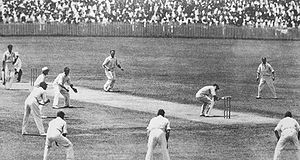
| ||
|---|---|---|
|
|
||
Bodyline, also known as fast leg theory bowling, was a cricketing tactic devised by the English cricket team for their 1932–33 Ashes tour of Australia. It was designed to combat the extraordinary batting skill of Australia's leading batsman, Don Bradman. A bodyline delivery was one in which the cricket ball was bowled at pace, aimed at the body of the batsman in the expectation that when he defended himself with his bat, a resulting deflection could be caught by one of several fielders deliberately placed nearby on the leg side.
At the time, no helmets or other upper-body protective gear was worn, and critics of the tactic considered it intimidating, and physically threatening in a game traditionally supposed to uphold conventions of sportsmanship.[1] The England team's use of the tactic was perceived by some, both in Australia and England, as overly aggressive or even unfair. It caused a controversy that rose to such a level that it threatened diplomatic relations between the two countries before the situation was calmed.[2][3]
Although no serious injuries arose from any short-pitched deliveries while a leg theory field was set, the tactic led to considerable ill feeling between the two teams, particularly when Australian batsmen were struck, inflaming spectators. After the introduction of helmets, short-pitched fast bowling, sometimes exceeding 90 miles per hour (140 km/h), continues to be permitted in cricket, even when aimed at the batsman, and is considered to be a legitimate bowling tactic when used sparingly. Over time, several Laws of Cricket were changed to render the bodyline tactic less effective—and increase player safety—such as a legside field restriction, concussion breaks and inspections.
- ^ Unit 2 – Managing the Match: Management issues and umpiring Archived 3 October 2011 at the Wayback Machine. International Institute of Cricket Umpiring and Scoring. Retrieved 2 September 2018.
- ^ Frith, pp. 241–59.
- ^ Cite error: The named reference
p2601was invoked but never defined (see the help page).
